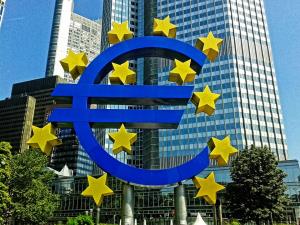The European Central Bank (ECB), creator of the Euro, currently claims to hold 504.8 tonnes of gold reserves. These gold holdings are reflected on the ECB balance sheet and arose from transfers made to the ECB by Euro member national central banks, mainly in January 1999 at the birth of the Euro. As of the end of December 2015, these ECB gold reserves were valued on the ECB balance sheet at market prices and amounted to €15.79 billion.Â
The ECB very recently confirmed to BullionStar that its gold reserves are stored across 5 international locations. However, the ECB also confirmed that it does not physically audit its gold, not will it divulge a bar list / weight list of these gold bar holdings.
Questions and Answers
BullionStar recently put a number of questions to the European Central Bank about the ECB’s gold holdings. The ECB Communications Directorate replied to these questions with answers that appear to include a number of facts about the ECB gold reserves which have not previously been published. The questions put to the ECB and its responses are listed below (underlining added):
Question 1: “The 2015 ECB Annual Report states that as at 31 December 2015, the ECB held 16,229,522 ounces of fine gold equivalent to 504.8 tonnes of gold. Given that the ECB gold holdings arose from transfers by the respective member central banks, could you confirm the storage locations in which this ECB gold is currently held (for example at the Bank of England etc), and the percentage breakdown of amount stored per storage location.â€
ECB Response: “The gold of the ECB is located in London, Paris, Lisbon, New York, and Rome. The ECB does not disclose its distribution over these places. The gold of the ECB is stored there because it was already stored there before ownership was transferred to the ECB and moving it was seen and is seen as too costly.“
Question 2: “Could you clarify as to how, if at all, this gold is audited, and whether it physical audited by the ECB or by a 3rd party?â€
ECB Response: “The ECB has no physical audit of its gold bars. The gold bars that the ECB owns are individually identified and each year the ECB receives a detailed statement of these gold deposits. The central banks where the gold is stored are totally reliable.“
Question 3: “Finally, can the ECB supply a full weight list of the gold bars that comprise the 504.8 tonnes of gold referred to above?â€
ECB Response: “The ECB does not disclose this information.“

London, New York, Paris, Rome, Lisbon
Given that some of the information shared by the ECB has arguably not been in the public record before, each of the 3 ECB answers above is worth further exploration.
In January 1999, when the Euro currency was created (Stage 3 of Economic and Monetary Union), each founding member national central bank (NCB) of the Euro transferred a quantity of foreign reserve assets to the ECB. Of these transfers, 85% was paid to the ECB in the form of US dollars and Japanese Yen, and 15% was paid to the ECB in the form of physical gold.
Initially, in January 1999, central banks of 11 countries that joined the Euro made these transfers to the ECB, and subsequently the central banks of a further 8 countries that later joined the Euro also executed similar transfers to the ECB.
All of the foreign exchange and gold reserves that were transferred to and are owned by the ECB are managed in a decentralised manner by the national central banks that initiated the transfers. Essentially, each national central bank acts as an agent for the ECB and each NCB still manages that portion of reserves that it transferred to the ECB. This also applies to the transferred gold and means that the gold transferred to the ECB never physically moved anywhere, it just stayed where it had been when the transfers of ownership were made.
That is why, as the ECB response to Question 1 states: “The gold of the ECB is stored there because it was already stored there before ownership was transferred to the ECBâ€.
What is probably most interesting about the latest ECB statement is that it names 5 city locations over which the ECB’s gold is stored. The 5 gold storage locations stated by the ECB are London, New York, Paris, Rome, and Lisbon. Since the gold transferred to the ECB in 1999 by the national central banks would have already been stored in central banks gold vaults, these 5 city locations undoubtedly refer to the gold vaults of:
- the Bank of England
- the Federal Reserve Bank of New York
- the Banque de France
- the Banca d’Italia
- Banco de Portugal
The fact the ECB’s gold holdings are supposedly stored at these 5 locations can be explained as follows:

Table 1: Central bank FX and Gold transfers to the ECB, January 1999
Between 4th and 7th January 1999, 11 central banks transferred a total of €39.469 billion in reserve assets to the ECB (in the form of gold, cash, and securities). Of this total, 15% was in the form of gold, amounting to 24 million ounces of gold (747 tonnes of gold) which was valued at that time at €246.368 per fine ounce of gold, or €5.92 billion. The 85% transferred in the form of currencies comprised 90% US Dollars and 10% Japanese Yen. See pages 152 and 153 of ECB annual report 1999for more details.
The 11 central banks that made the transfers to the ECB in January 1999 were the central banks of Belgium, Netherlands, Germany, France, Luxembourg, Italy, Ireland, Austria, Finland, Spain and Portugal. See Table 1 for details of these gold transfers, and the amount of gold transferred to ECB ownership by each central bank.

